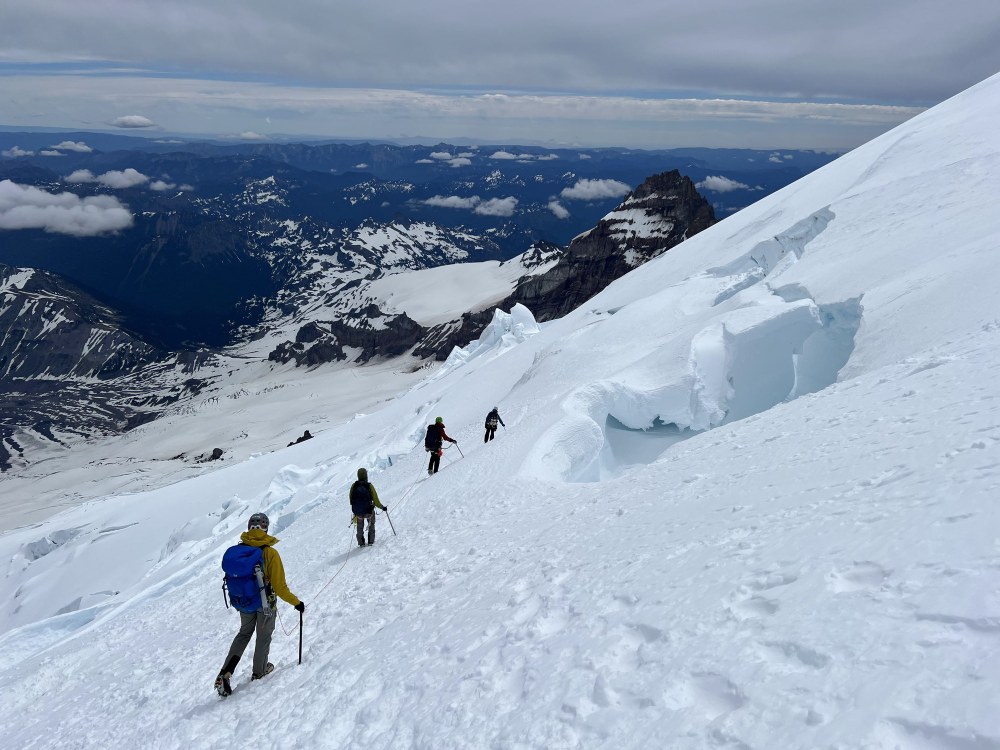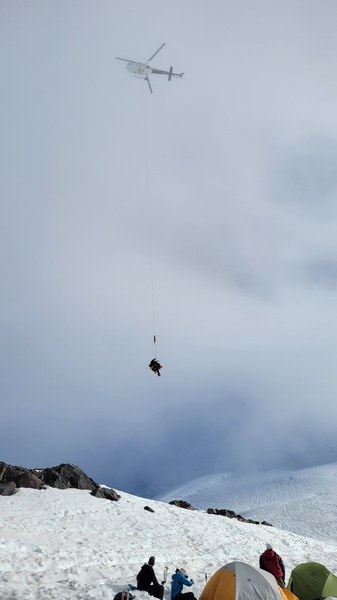
The weekend of July 8, I was helping lead a Mountaineers climb of the Emmons Route on Mt. Rainier. Our team was fortunate to have great weather and even better route conditions, and everyone on our two rope teams made it safely to the summit and back to the White River trailhead with no mishaps.
As is common in July, the mountain was busy, and it appeared that many parties also summited successfully; spirits were high along the climbing route and back at base camp.
Coming down the Corridor - a relatively low-angle stretch of the Emmons Glacier that extends 1,500 vertical feet above Camp Schurman - I noticed something strange: a glissade track running several hundred feet down the Emmons Glacier. The Corridor looked fairly innocuous when covered by a blanket of snow, but large crevasses lurked below the surface in the underbelly of the Emmons Glacier. It’s definitely not a good place to be unroped and glissading, which is why I took note of the glissade track.
I would come to learn that our pleasant summit weekend was not without incident. On Saturday afternoon, as we were unwinding back at Camp Schurman, we witnessed a high wire (helicopter short-haul) rescue of a skier who we heard took a crevasse fall high on the upper mountain. Seeing this harrowing helicopter rescue, right on the heels of observing the ill-advised glissade track on the Corridor, was a good reminder that being complacent on a big mountain often leads to dangerous outcomes.
 A high wire (helicopter short-haul) rescue of a skier at Mt. Rainier. Photo by Tom Vogl.
A high wire (helicopter short-haul) rescue of a skier at Mt. Rainier. Photo by Tom Vogl.
A post on the Mt. Rainier Climbing blog, titled Please Rope Up, puts it simply: “It is always the crevasse that you’re not planning on falling into that causes the most problems.” Whether you’re planning on climbing a big mountain, like Mt. Rainier, or are just looking to learn more, read Please Rope Up and heed the advice of the experts who rescue dozens of injured climbers and skiers each month during peak climbing season.
“Don’t assume the one party you see employing a certain style of glacier travel techniques knows what they are doing, especially if that style takes on more risk than just walking, roped-up,” says Stefan Lofgren, the park’s climbing program manager. This may start a chain reaction of mimicry. Make decisions that maximize the safety of your team. Speed is not always the right factor to place first unless you are highly skilled and experienced.
As I reflected on our recent trip on the Emmons and other observations I’ve made over time, here are six things I think every climber or ski mountaineer should keep in mind on mountains like Rainier:
- Rope up on glaciers: even places like the Corridor or the Inter Glacier have large crevasses that can hurt or kill you.
- Don’t glissade on glaciers: glissading can be a fun and efficient way to get down a snow slope, but you should only glissade when it can be done safely.
- Keep the team together: “All for one, one for all.” Never send a solo or less-experienced team down by themselves unless there is a qualified leader like yourself who knows what they are doing and where they are going. Don’t split up! Splitting up is a major cause of rescues high on Mt. Rainier.
- Know before you go: mountaineering is a complicated activity and you need to have the know-how to protect you and your party and perform a rescue if necessary. Track the weather, assess conditions along the way, and adjust your plans accordingly.
- Ski/descend conservatively: ski mountaineering requires a completely different level of expertise than climbing glaciers. Only ski glaciers if you have the training and experience to assess objective hazards, make good decisions, and manage incidents that occur.
- Practice your skills: keep your techniques sharp by practicing them in an easier, more controlled environment than you’re likely to encounter on the upper mountain. Performing a crevasse rescue high on the mountain will invariably be more challenging than when you practice closer to home.
The park rangers do an incredible job helping our community respond to incidents. We’re grateful for the many ways they help us explore and enjoy the mountains. Accidents sometimes happen, but we should all do our part to help reduce their frequency and severity by planning ahead and climbing responsibly.
Lead image of Roped-up climbers descending the Emmons Route of Mt. Rainier. Photo by Serene Chen.
Add a comment
Log in to add comments.Outstanding Safety reminder Tom!! Thanks for encouraging glacier travel techniques to remain top of mind as we get out into the alpine.
 Tom Vogl
Tom Vogl